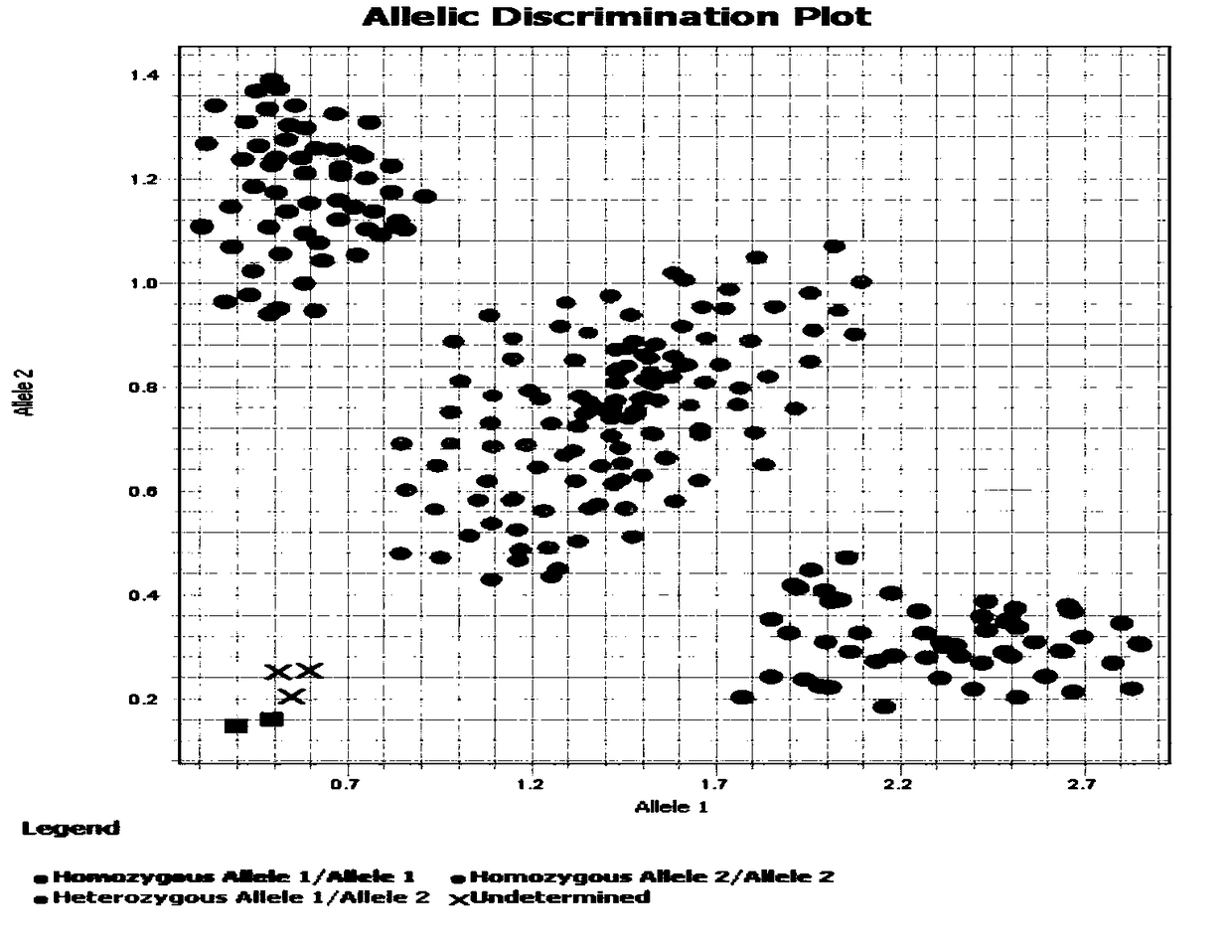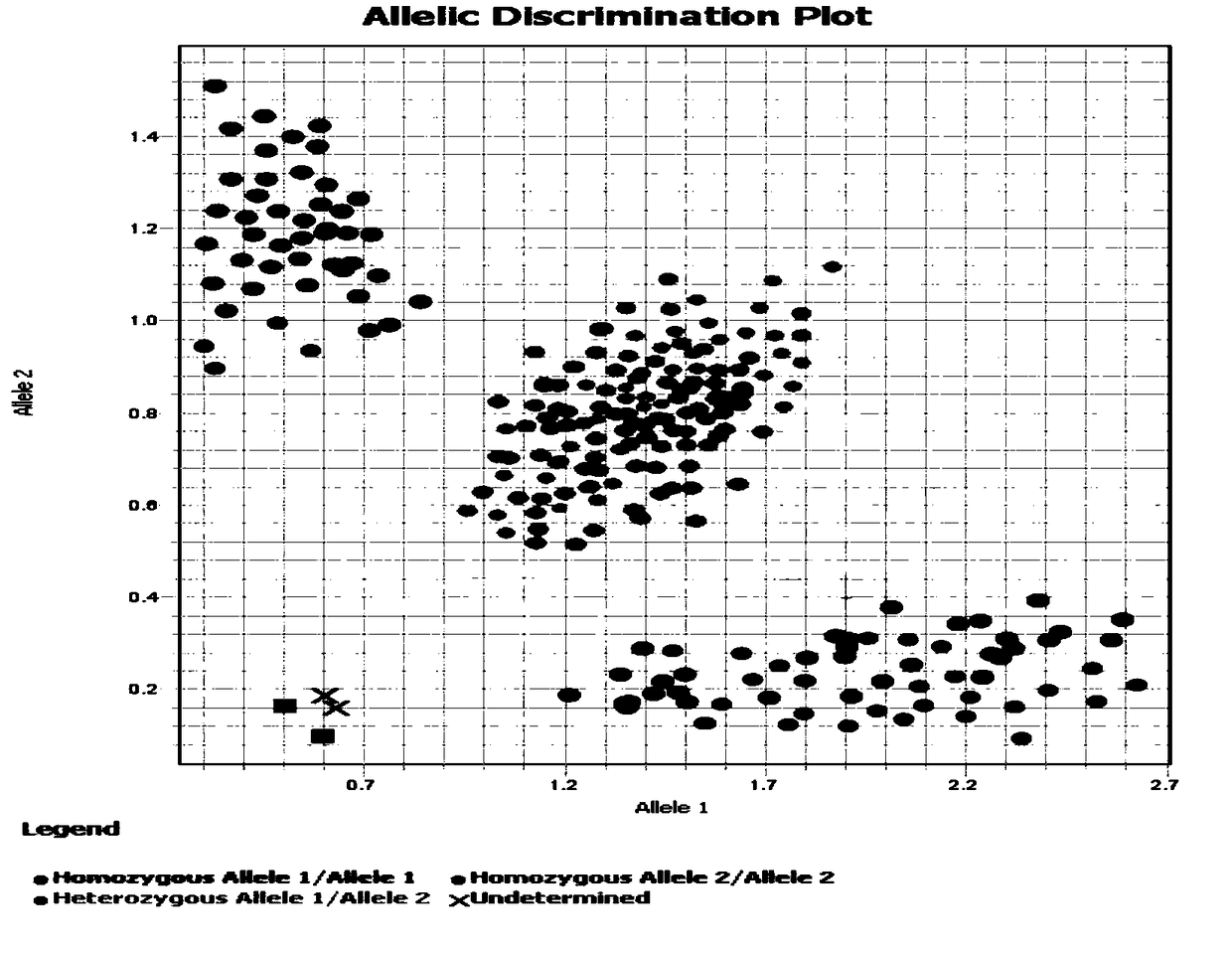High-throughput detection markers of wheat powdery mildew resistance gene Pm5e and application of detection markers in breeding
A technology for powdery mildew resistance gene and wheat powdery mildew, which is applied in the determination/inspection of microorganisms, DNA/RNA fragments, recombinant DNA technology, etc., can solve the problems of low polymorphism level, low detection efficiency, long genetic distance, etc. Achieve the effect of improving powdery mildew resistance, reducing impact and improving breeding efficiency
- Summary
- Abstract
- Description
- Claims
- Application Information
AI Technical Summary
Problems solved by technology
Method used
Image
Examples
Embodiment 1
[0056] Embodiment 1: Wheat genome DNA extraction
[0057] 1) Collection of leaves for DNA extraction
[0058] At the three-leaf stage of wheat, young leaves of wheat were selected and put into the corresponding 96-well deep-well plate according to the number. In order to prevent DNA degradation, the operation was performed on an ice box;
[0059] 2) Genomic DNA of wheat was extracted by CTAB method; stored at -20°C for future use.
[0060] The above steps are as follows:
[0061] (a) take young wheat leaves and place them in a 96-well deep-well plate, freeze them with liquid nitrogen and grind them into powder on a tissue grinder; (b) preheat them in each well of the 96-well deep-well plate Put 600 μL of CTAB extract at 65°C in a water bath at 65°C for 60 minutes, and shake gently every 10 minutes to fully lyse the DNA; (c) add 600 μL of chloroform-isoamyl alcohol mixture with a volume ratio of 24:1, and shake gently for 10 minutes ; (d) Centrifuge at 12000r for 10min at 4°...
Embodiment 2
[0077] Example 2: Development of Tightly Linked Markers in Pm5e Gene in Rejuvenation 30
[0078]Currently, 6 markers closely linked to Pm5e have been published, including 4 SSR markers (Xgwm783, Xgwm1267, Xwmc364 and Xbarc065) and 2 EST markers (CJ729392 and CJ584170). Due to the low specificity of SSR markers, the KASP detection marker developed in this study is based on two EST markers. The disease-resistant material Rejuvenation 30 contains the Pm5e gene, and Chancellor is highly susceptible to powdery mildew. Using these two resistant parents to create F 2 A total of 214 plants were isolated from the population, and the powdery mildew phenotype was identified at the seedling and adult plant stages. According to the identification results, select F with high resistance and high sensitivity respectively. 2 15 individual plants were used to construct resistance and susceptibility gene pools. Using 35K gene chip technology to identify the SNP sites of the anti-susceptibili...
Embodiment 3
[0079] Example 3: Primer dilution and KASP assay primer mix:
[0080] After diluting the three primers of AX-95000860 to 100 μM with Tris HCl, according to the volume ratio AX-95000860-KASP-FAM_C-R:AX-95000860-KASP-HEX_T-S:AX-95000860-KASP-R:Tris HCl=6 : 6: 15: 23 ratio, aliquoted and stored at -20°C, used as KASP assay primers.
[0081] The dilution and mixing method of AX-94638908 primer is the same as AX-95000860.
PUM
 Login to View More
Login to View More Abstract
Description
Claims
Application Information
 Login to View More
Login to View More - R&D Engineer
- R&D Manager
- IP Professional
- Industry Leading Data Capabilities
- Powerful AI technology
- Patent DNA Extraction
Browse by: Latest US Patents, China's latest patents, Technical Efficacy Thesaurus, Application Domain, Technology Topic, Popular Technical Reports.
© 2024 PatSnap. All rights reserved.Legal|Privacy policy|Modern Slavery Act Transparency Statement|Sitemap|About US| Contact US: help@patsnap.com










